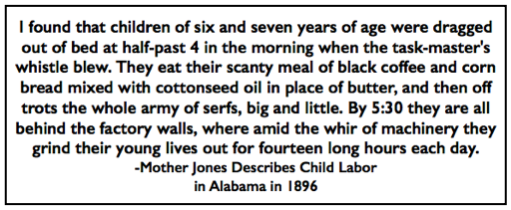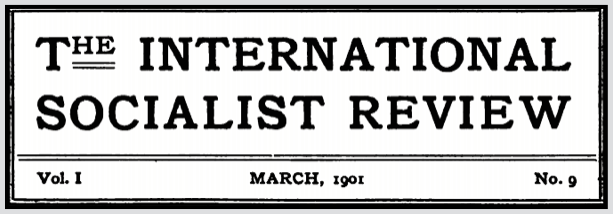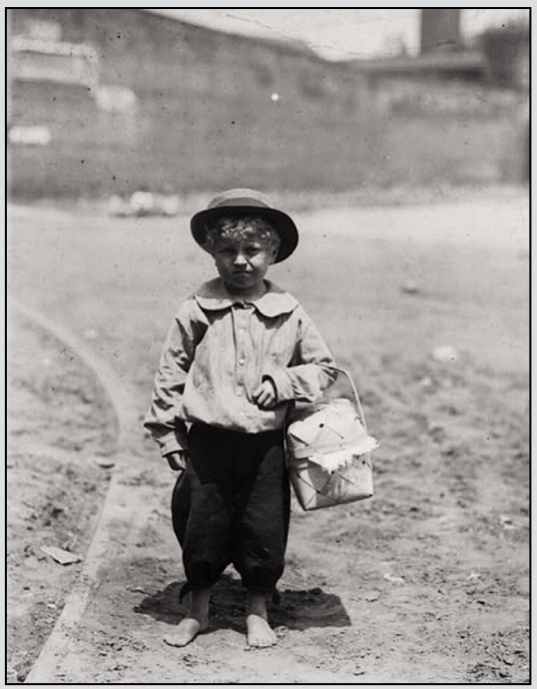 ———-
———-
Hellraisers Journal – Friday March 1, 1901
Mother Jones Remembers “Civilization in Southern Mills” of 1896
From the International Socialist Review of March 1901:
Civilization in Southern Mills
———-
The miners and railroad boys of Birmingham, Ala., entertained me one evening some months ago with a graphic description of the conditions among the slaves of the Southern cotton mills. While I imagined that these must be something of a modern Siberia, I concluded that the boys were overdrawing the picture and made up my mind to see for myself the conditions described. Accordingly I got a job and mingled with the workers in the mill and in their homes. I found that children of six and seven years of age were dragged out of bed at half-past 4 in the morning when the task-master’s whistle blew. They eat their scanty meal of black coffee and corn bread mixed with cottonseed oil in place of butter, and then off trots the whole army of serfs, big and little. By 5:30 they are all behind the factory walls, where amid the whir of machinery they grind their young lives out for fourteen long hours each day. As one looks on this brood of helpless human souls one could almost hear their voices cry out, “Be still a moment, O you iron wheels or capitalistic greed, and let us hear each other’s voices, and let us feel for a moment that this is not all of life.”
We stopped at 12 for a scanty lunch and a half-hour’s rest. At 12:30 we were at it again with never a stop until 7. Then a dreary march home, where we swallowed our scanty supper, talked for a few minutes of our misery and then dropped down upon a pallet of straw, to lie until the whistle should once more awaken us, summoning babes and all alike to another round of toil and misery.
I have seen mothers take their babes and slap cold water in their face to wake the poor little things. I have watched them all day long tending the dangerous machinery. I have seen their helpless limbs torn off, and then when they were disabled and of no more use to their master, thrown out to die. I must give the company credit for having hired a Sunday school teacher to tell the little things that “Jesus put it into the heart of Mr. – to build that factory so they would have work with which to earn a little money to enable them to put a nickel in the box for the poor little heathen Chinese babies.”
The Rope Factory
I visited the factory in Tuscaloosa, Ala., at 10 o’clock at night. The superintendent, not knowing my mission, gave me the entire freedom of the factory, and I made good use of it. Standing by a siding that contained 155 spindles were two little girls. I asked a man standing near if the children were his, and he replied that they were. “How old are they?” I asked. “This one is 9, the other 10,” he replied. “How many hours do they work?” “Twelve,” was the answer. “How much do they get a night?” “We all three together get 60 cents. They get 10 cents each and I 40.”
I watched them as they left their slave-pen in the morning and saw them gather their rags around their frail forms to hide them from the wintry blast. Half-fed, half-clothed, half-housed, they toil on, while the poodle dogs of their masters are petted and coddled and sleep on pillows of down, and the capitalistic judges jail the agitators that would dare to help these helpless ones to better their condition.
Gibson is another of those little sections of hell with which the South is covered. The weaving of gingham is the principal work. The town is owned by a banker who possesses both people and mills. One of his slaves told me she had received one dollar for her labor for one year. Every weekly pay day her employer gave her a dollar. On Monday she deposited that dollar in the “pluck-me” store to secure food enough to last until the next pay day, and so on week after week.
There was once a law on the statute books of Alabama prohibiting the employment of children under twelve years of age more than eight hours each day. The Gadston Company would not build their mill until they were promised that this law should be repealed.
When the repeal came up for the final reading I find by an examination of the records of the House that there were sixty members present. Of these, fifty-seven voted for the repeal and but three against. To the everlasting credit of young Manning, who was a member of that House, let it be stated that he both spoke and voted against the appeal.
I asked one member of the House why he voted to murder the children, and he replied that he did not think they could earn enough to support themselves if they only worked eight hours. These are the kind of tools the intelligent workingmen put in office.
The Phoenix mill in [Columbus] Georgia were considering the possibility of a cut in wages something over a year ago, but after making one attempt they reconsidered and started a savings bank instead. At the end of six months the board of directors met and found out that the poor wretches who were creating wealth for them were saving 10 per cent of their wages. Whereupon they promptly cut them that 10 per cent, and the result was the ’96 strike. I wonder how long the American people will remain silent under such conditions as these.
Almost every one of my shop-mates in these mills was a victim of some disease or other. All are worked to the limit of existence. The weavers are expected to weave so many yards of cloth each working day. To come short of this estimate jeopardizes their job. The factory operator loses all energy either of body or of mind. The brain is so crushed as to be incapable of thinking, and one who mingles with these people soon discovers that their minds like their bodies are wrecked. Loss of sleep and loss of rest gives rise to abnormal appetites, indigestion, shrinkage of stature, bend backs and aching hearts.
Such a factory system is one of torture and murder as dreadful as an long-drawn-out Turkish massacre, and is a disgrace to any race or age. As the picture rises before me I shudder for the future of a nation that is building up a moneyed aristocracy out of the life-blood of the children of the proletariat. It seems as if our flag is a funeral bandage splotched with blood. The whole picture is one of the most horrible avarice, selfishness and cruelty and is fraught with present horror and promise of future degeneration. The mother, over-worked and under-fed, gives birth to tired and worn-out human beings.
I can see no way out save in a complete overthrow of the capitalistic system, and to me the father who casts a vote for the continuance of that system is as much of a murderer as if he took a pistol and shot his own children. But I see all around me signs of the dawning of the new day of socialism, and with my faithful comrades everywhere I will work and hope and pray for the coming of that better day.
Mother Jones
[Emphasis added.]
~~~~~~~~~~~~~~~~~~~~~~
SOURCES & IMAGES
International Socialist Review
(Chicago, Illinois)
-Mar 1901
https://www.marxists.org/history/usa/pubs/isr/v01n09-mar-1901-ISR-gog-Wisc.pdf
May 9, 1896, Appeal to Reason-Mother Jones in Alabama and Georgia investigating factory conditions.
https://www.newspapers.com/clip/72449161/may-9-1896-appeal-to-reason-mother/
See also:
Hellraisers Journal – Tuesday October 27, 1908
Mother Jones Visits Girard; Reports on Child Labor in Alabama
(Note: Mother states she has not been with the workers of Alabama for 13 years.)
“Jane Addams’ and Rev. Edgar Murphy’s Views on Child Labor Reform in 1903” Note: Murphy was founder of Child Labor Committee of Alabama.
https://socialwelfare.library.vcu.edu/programs/hild-labor-reform-views-1903/
“National Child Labor Committee (NCLC): Founded April 25, 1904”
By Catherine A. Paul
https://socialwelfare.library.vcu.edu/programs/child-welfarechild-labor/national-child-labor-committee/
Toter Tot by Lewis Hine
Eagle and Phoenix Mill of Columbus GA, Apr 1913
https://www.loc.gov/pictures/item/2018675210/
Eagle and Phoenix Mill. “Dinner-toters” waiting for the gate to open. This is carried on more in Columbus than in any other city I know, and by smaller children. (See photos.) Many of them are paid by the week for doing it, and carry, sometimes ten or more a day. They go around in the mill, often help tend to the machines, which often run at noon, and so learn the work. A teacher told me the mothers expect the children to learn this way, long before they are of proper age. Location: Columbus, Georgia.
Search LoC: hine april 1913
-scroll down for “Dinner-toters”
https://www.loc.gov/pictures/search/?q=hine%20april%201913
~~~~~~~~~~~~~~~~~~~~~~~~~~~~~~~~~~~~~
Babies In The Mill – Dorsey Dixon




